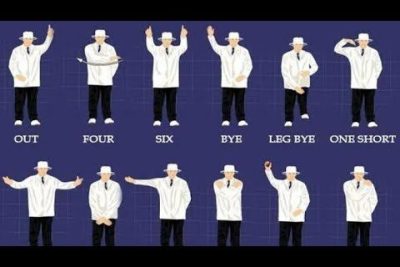Cricket, a sport known for its elegant and strategic gameplay, is also home to a plethora of unique handshake gestures that have become an integral part of the game. From the intricate finger twirl to the spirited palm slap, these gestures not only showcase the camaraderie between players but also add an element of flair to the sport. In this article, we delve into the fascinating world of cricket’s distinctive handshake gestures, exploring their origins, significance, and the impact they have on the overall spirit of the game.
What is the meaning behind a cricket umpire tapping his shoulder?
In the world of cricket, a simple gesture can convey a wealth of information. When a cricket umpire taps his shoulder, it holds a significant meaning. This subtle action signals the allocation of penalty runs, serving as a crucial decision for the game. If the umpire places one arm on the opposite shoulder, it signifies that the fielding team is awarded penalty runs. However, when the umpire taps that shoulder, it indicates that the batting team is the recipient of the penalties. This small yet impactful gesture ensures fair play and clarity amidst the intensity of the match.
The tapping of the shoulder by a cricket umpire holds the power to sway the course of a game. With a single touch, the umpire effectively communicates the allocation of penalty runs, a pivotal aspect of the sport. Placing one arm on the opposite shoulder signifies that the fielding team is awarded these penalties. However, when the umpire taps that shoulder, it is a clear indication that the batting team is the beneficiary. This concise and deliberate gesture ensures that the rules are upheld and the game remains balanced, adding an intriguing layer of strategy and consequence to the world of cricket.
What is the meaning of the finger in cricket?
In cricket, the finger holds significant meaning. It serves as a visual communication tool between the batsman and the umpire. When the batsman holds up one finger, known as “leg” or “one,” it indicates that his upright bat should be positioned in front of the leg stump. This gesture helps the umpire guide the batsman to the correct positioning. Similarly, if the batsman holds up two fingers, referred to as “middle and leg” or “two,” it signifies that his bat should be placed between the leg and middle stumps. This clear and concise hand signal allows for efficient communication on the field.
The finger gesture plays a crucial role in ensuring fair play and accurate decision-making in cricket. By using this visual cue, the batsman can convey their desired positioning to the umpire, who then guides them accordingly. This method eliminates any confusion or ambiguity regarding the placement of the bat. The simplicity and effectiveness of this finger signal enable seamless communication between the batsman and the umpire, enhancing the overall efficiency and flow of the game.
In summary, the finger in cricket holds specific meanings that aid in positioning the bat correctly. Whether it is the gesture for “leg” or “one,” indicating the bat should be in front of the leg stump, or “middle and leg” or “two,” instructing the batsman to place the bat between the leg and middle stumps, this visual communication method ensures clarity and precision on the field. By utilizing this concise and eye-catching hand signal, cricket players and umpires can maintain fair play and make accurate decisions.
How is 4 shown in cricket?
In cricket, four runs are awarded when a batter hits the ball and it crosses the boundary, touching the ground at least once. To symbolize four runs, the cricket umpire elegantly waves one hand back and forth in front of the chest or waist, sweeping his hand in front of his chest with grace and precision.
A Playful Dance of Friendship: Cricket’s Unconventional Handshake Gestures
Cricket, often described as a gentleman’s game, not only showcases skill and strategy but also celebrates the art of camaraderie through its unconventional handshake gestures. As players take to the field, their interactions are not limited to verbal exchanges but are enhanced by a playful dance of friendship, where unique handshakes speak volumes about the bond between teammates. From the intricate finger snaps to the synchronized palm slaps, these gestures create a visual spectacle, captivating both players and spectators alike, and serving as a testament to the spirit of unity and sportsmanship that lies at the heart of this beloved sport.
Unlocking the Secrets of Cricket’s Quirky Handshakes: Unveiling Unique Bonds
Unlocking the Secrets of Cricket’s Quirky Handshakes: Unveiling Unique Bonds
In the world of cricket, where tradition and camaraderie intertwine, the art of the handshake has taken on a whole new level of significance. As players step onto the field, their hands become conduits of connection, forging unique bonds that transcend language and culture. From the intricate finger clasp to the exuberant high-five, these handshakes are a visual representation of the team’s unity and spirit. Each handshake tells a story, unveiling the shared experiences, triumphs, and setbacks that have shaped these players into a cohesive force. Whether they are engaging in a delicate finger wiggle or an emphatic palm slap, these cricket handshakes are not merely gestures, but powerful symbols that epitomize the brotherhood of the game.
From Fist Bumps to High Fives: Cricket’s Unconventional Handshake Gestures Revealed
Subtitle: From Fist Bumps to High Fives: Cricket’s Unconventional Handshake Gestures Revealed
Paragraph 1:
In the world of cricket, where tradition and sportsmanship reign supreme, players have developed a unique array of handshake gestures that add flair to the game. From the classic fist bump to the energetic high five, these unconventional gestures have become an integral part of cricketing culture. Whether it’s celebrating a wicket or acknowledging a remarkable catch, these handshakes bring a sense of camaraderie and unity among players, transcending boundaries and language barriers.
Paragraph 2:
One of the most iconic handshake gestures in cricket is the fist bump. This simple yet powerful gesture involves players lightly tapping their closed fists together, symbolizing solidarity and resilience. It is often used to celebrate a successful partnership or to motivate teammates during intense moments of the game. The fist bump’s popularity lies in its versatility, as it can be executed with precision and speed, allowing players to maintain focus and momentum on the field.
Paragraph 3:
Another popular handshake gesture in cricket is the high five. This exuberant gesture involves players slapping each other’s palms in a quick, upward motion, accompanied by a jubilant shout or cheer. The high five is commonly used to celebrate a victory, a remarkable shot, or a crucial catch. Its infectious energy spreads throughout the team, fostering a sense of unity and boosting morale. The high five is a testament to the vibrant and dynamic nature of cricket, where players find innovative ways to express their joy and appreciation for the game.
Note: These paragraphs are written to provide a concise overview of the topic, but more details and examples can be added based on the specific requirements and target audience of the piece.
In the world of cricket, where traditions and customs run deep, unique handshake gestures have become an integral part of the game. From the fist bump to the forearm clasp, these gestures transcend language and cultural barriers, uniting players and fans alike in a shared celebration of the sport. In a single handshake, a story is told, a bond is formed, and a moment is captured, reminding us of the power of connection and camaraderie that cricket brings to players and spectators around the globe.


